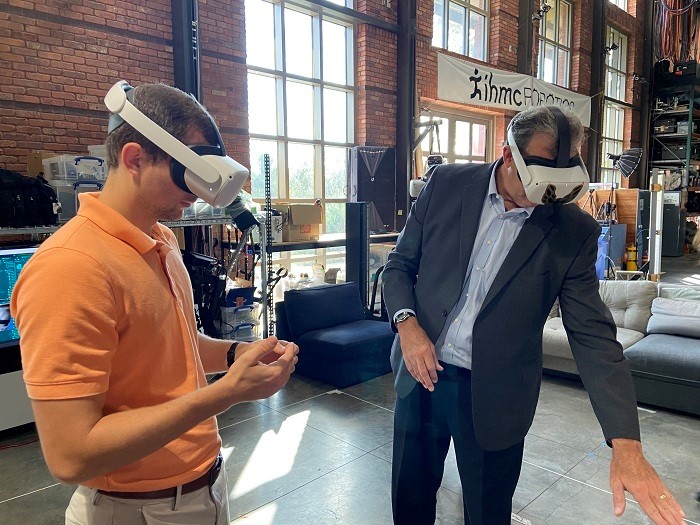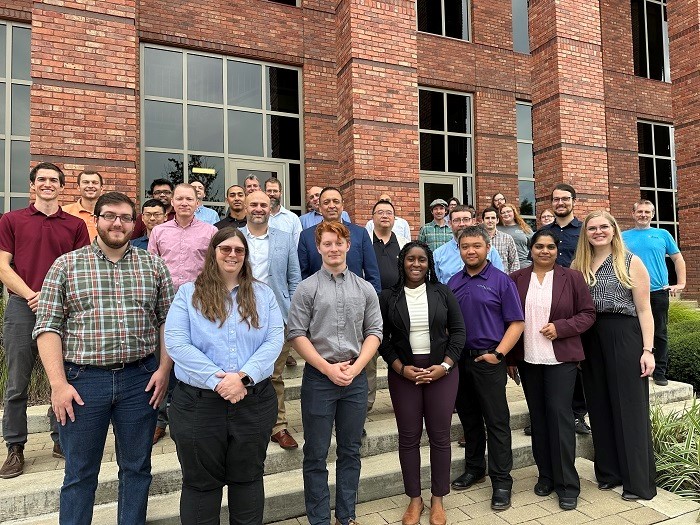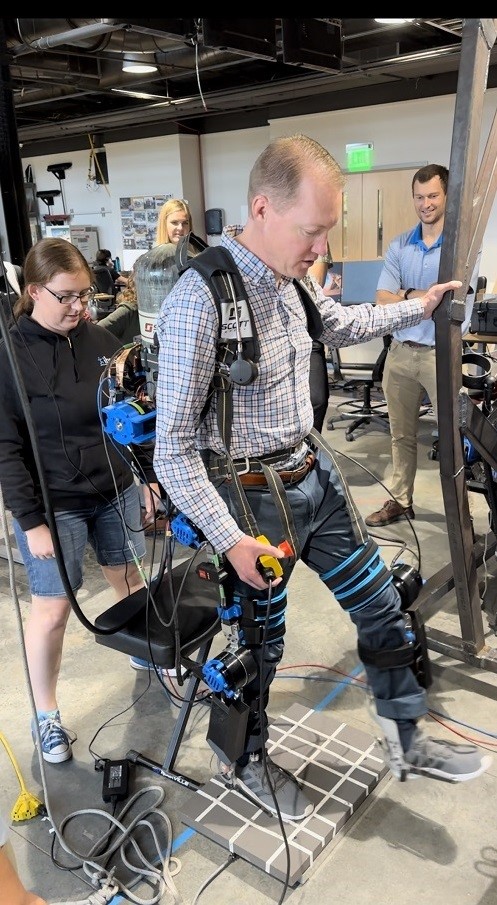
Nicholas Spivey, left, a mechanical engineer with Instrumentation, Robotics, and Imaging Systems at Savannah River National Laboratory, and Kurt Gerdes, director of EM’s Office of Technology Development, use virtual reality simulation of an EM worksite during meetings held at the Florida Institute for Human and Machine Cognition in Pensacola.
PENSACOLA, Fla. – Donning devices that help relieve stress on workers’ muscles and joints or create a virtual reality simulating a worksite, more than 40 members of a team recently met in person for the first time since fiscal 2020 to evaluate technology to improve the safety and well-being of EM’s workforce.
The team gathered at the Florida Institute for Human and Machine Cognition (IHMC) in Pensacola. IHMC is among the organizations EM has funded to develop and test the wearable devices for members of EM’s workforce who perform a variety of physically challenging tasks.
“Nothing we do is more important than protecting the health and safety of our workforce,” said Kurt Gerdes, director of the EM Office of Technology Development. “This program has the potential to create new approaches to addressing that key challenge.”

More than 40 members of a team evaluating wearable robotic devices for the EM workforce gather for a photo during recent meetings at the Florida Institute for Human and Machine Cognition in Pensacola.
The meetings included demonstrations of IHMC’s prototype exoskeleton for tank farm workers across the EM complex and a virtual reality simulation of an EM worksite.
An exoskeleton is a device worn by a person that provides support to muscles and joints or transfers a load to another part of the body or the ground. A wearable robotic device is an exoskeleton that includes sensors, motors and controllers that intelligently apply assistance to the wearer.
At the meetings at IHMC, team members shared updates on their current research and development, including studies of the physical impact of wearable devices in EM tasks, pilot testing at multiple cleanup sites and development of devices tailored to the unique needs of EM workers, including compatibility with personal protective equipment.
Initial results of those studies are encouraging. The team is exploring several potential applications of the technology across the EM complex in the short term. To meet the broader needs of the cleanup complex, additional technology evaluation will continue.
Breakout meetings at IHMC allowed more detailed discussions of key considerations related to the potential application of the devices, including contamination management and methods for measuring success.

Jean P. Pabón, left, project manager with the EM Office of Technology Development Program, and Leo Lagos, director of research at the Applied Research Center at Florida International University, test virtual reality simulation of an EM worksite.

Jason Wheeler, a research and development staff member at Sandia National Laboratories, tries on a prototype exoskeleton for tank farm workers developed by the Florida Institute for Human and Machine Cognition. Wheeler is part of the team exploring wearable robotics and exoskeletons for EM’s workforce.
Representatives from all the funded organizations that work on the technology development and evaluation program attended the meetings. They included Sandia National Laboratories, which leads the effort; EM’s Savannah River National Laboratory; Los Alamos National Laboratory; Georgia Institute of Technology; Florida International University; and IHMC. Gerdes and Project Manager Jean P. Pabón with the EM Office of Technology Development, and employees from the Hanford Site also attended the meetings.
Launched in fiscal 2020, the technology development and evaluation program works with sites across the EM complex to identify repetitive, physically demanding tasks that may be made easier using wearable devices.
“Bringing the diverse team together provided unique opportunities for collaboration and idea sharing that are much more difficult to achieve in virtual formats,” Pabón said.
The team intends to continue holding in-person meetings twice per year at locations of team members or EM sites as efforts move forward to provide workers with the best possible tools to be safe as they work to complete EM’s cleanup mission.
-Contributor: Jason Wheeler